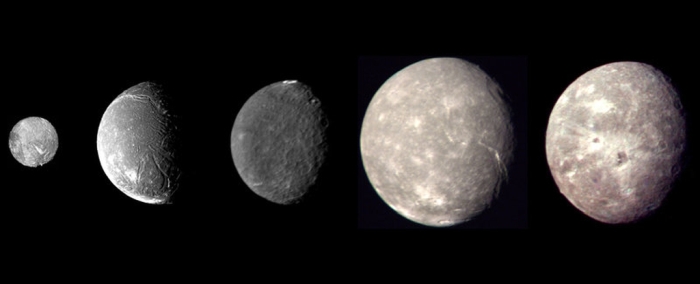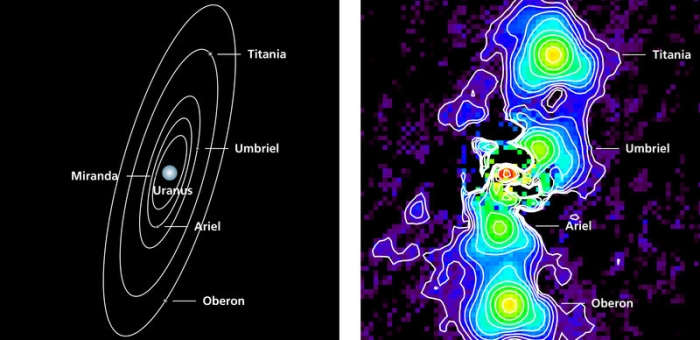
Uranus, a long way from Earth in the hazier locale of the Nearby planetary group's planetary reach, isn't the only one. It's joined by an entourage of moons - 27, to be exact. Far and diminish, these moons are hard to consider, however cosmologists have made an incidental revelation while watching Uranus.
As per infrared pictures of the five primary moons of Uranus, their creation is nearer to that of bantam planets like Pluto and Haumea - minimized, rough articles with a cold hull - than the more feathery piece of the littler Uranian moons.
Uranus circles the Sun at a normal separation around multiple times that of Earth. We haven't sent numerous rocket out that far - just NASA's Explorer 2 shuttle has had a nearby experience with Uranus, in 1986 on its way to the edge of the Close planetary system and past.
Aside from those Explorer 2 perceptions, our investigation of the planet and its satellites has depended on telescopes nearer to home - on Earth, and in Earth's orbital region. That makes the moons testing to see; they're a lot littler and reflect substantially less daylight than Uranus, so they come to the heart of the matter of intangibility.
"The moons, which are somewhere in the range of 500 and multiple times fainter, are at such a little good ways from Uranus that they converge with the correspondingly brilliant relics," said stargazer Gábor Marton of Konkoly Observatory in Hungary. "Just the most splendid moons, Titania and Oberon, stand apart a little from the encompassing glare."
Which makes an incidental discovery of the five moons by the European Space Office's Herschel Space Observatory, in activity somewhere in the range of 2009 and 2013 to consider the cosmic system in infrared radiation, very awesome.
"As a matter of fact, we completed the perceptions to quantify the impact of brilliant infrared sources, for example, Uranus on the camera identifier," said space expert Ulrich Klaas of the Maximum Planck Organization for Cosmology in Germany
"We found the moons just by chance as extra hubs in the planet's very brilliant sign."
 From left to right: Miranda, Ariel, Umbriel, Titania and Oberon, imaged by Voyager 2 in 1986. (NASA/JPL/MPIA)
From left to right: Miranda, Ariel, Umbriel, Titania and Oberon, imaged by Voyager 2 in 1986. (NASA/JPL/MPIA)
The five principle moons of Uranus are, in dropping request of size, Titania, Oberon, Umbriel, Ariel, and Miranda. Explorer 2 uncovered that each of the five have an adjusted shape that demonstrates they have accomplished hydrostatic balance - that is, sufficient mass to build up an even, adjusted shape under their own gravity. What's more, they appear to be made out of rock and ice.
That is not strange for objects that a long way from the Sun. In any event, when warmed by the Sun, the temperatures of Uranus and its moons just get as high as somewhere in the range of 60 and 80 Kelvin (- 213 to - 193 degrees Celsius, or - 350 to - 315 degrees Fahrenheit) at the surface. Pluto is extremely rough and frigid.
However, how that rock and ice is assembled matters. The whimsical circles of Uranus' littler, unpredictable, hilter kilter moons proposes they have a sythesis fundamentally the same as the rough bodies in the Kuiper Belt out past Neptune, the trans-Neptunian objects. These are just approximately bound together, and tiny.
"This would likewise fit with the hypotheses about the source of the sporadic moons," said astrophysicist Thomas Müller of the Maximum Planck Establishment for Extraterrestrial Material science in Germany. "Due to their clamorous circles, it is accepted that they were caught by the Uranian framework just sometime in the not too distant future."
Normally, the five fundamental moons, which circle Uranus' equator, would be hard to see. Uranus has an unusual direction, tipped on its side concerning its orbital plane around the Sun, so its equator is regularly in shadow.
 (T. Müller [HdA]/Ö. H. Detre et al./MPIA)
(T. Müller [HdA]/Ö. H. Detre et al./MPIA)
During the group's perceptions of Uranus somewhere in the range of 2010 and 2012, notwithstanding, the equator was taking into account the telescope and in the daylight. Furthermore, when the group deducted Uranus from the information utilizing an extraordinarily evolved calculation, something stunning rose.
"We were completely shocked when four moons plainly showed up on the pictures, and we could even identify Miranda, the littlest and deepest of the five biggest Uranian moons," said cosmologist Örs H. Detre of the Maximum Planck Foundation for Stargazing.
This empowered the group to gauge how well warmth from the Sun was held in the surfaces of the moon as that surface turned away into night. These surfaces, it turned out, held warmth very well, chilling off generally gradually.
It was a natural warmth maintenance and cooling profile - the nearest coordinate is bantam planets like Pluto and Haumea, with their thick rough bodies and ice-encrusted surfaces. This proposes Titania, Oberon, Umbriel, Ariel and Miranda are manufactured a similar way - in spite of the fact that the specific synthetic structure of the stone and the ice subsequently is yet to be resolved.
The finding could imply that sending a test to the ice monsters could assist us with studying more inaccessible items, much further away in the diminish spans of the Kuiper Belt. Be that as it may, it additionally shows the benefit of looking directly in front of us.
"The outcome exhibits that we don't generally require expand planetary space missions to increase new experiences into the Close planetary system," said stargazer Hendrik Linz of the Maximum Planck Foundation for Cosmology.
"What's more, the new calculation could be applied to encourage perceptions which have been gathered in enormous numbers in the electronic information file of the European Space Office ESA. Who realizes what shock is as yet sitting tight for us there?"





No comments:
Post a Comment